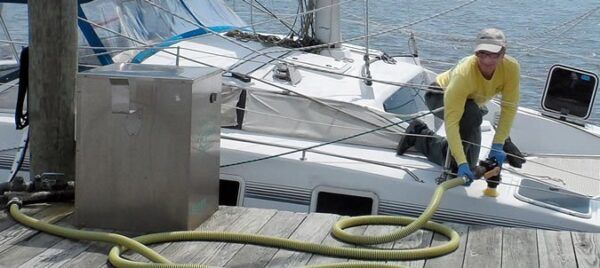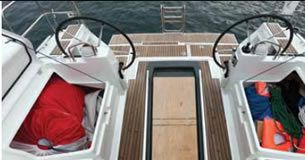While its possible the waste pump-out line on the boat is plugged, most pump-out problems can be traced to poor procedure. Instructions on the pump-out station-if provided at all-overlook key factors, probably because the bureaucrat who wrote them didn’t actually understand the process. Here are some tips on doing it right.
Get everything ready before you start the pump. The pump is often on a timer. Rushing around results in short cuts. Secure the boat. Put on gloves. Bring the water hose to the work area and turn on the main valve. Remove the deckplate. Remove the entire vacuum hose from the reel or holder and place the entire hose flat on the dock even if you do not need the full length. Failure to do this is the most common reason for pump-out failure or slow pumping. Leaving it coiled and hanging from its hook can be the same as adding about 22 feet of vertical lift, which most pumps can’t overcome.
Start the pump and allow 10-20 seconds for vacuum to build. Hold the cone adapter firmly in the hole and open the valve quickly. By allowing the vacuum to build and opening the valve quickly, the suction hits the sludge at the bottom of the pump-out pipe suddenly, breaking resistance more effectively than a slow start. If flow does not start within 20 seconds, close the valve, wait for vacuum to build, and repeat.
Listen for leaks
Listen for air leaks around the universal adapter. If there is any hissing, make certain the adapter is at 90 degrees to the outlet, put your shoulders over the adapter and apply some vertical pressure. If it still hisses, direct a small stream of freshwater from the clean-up hose around the gap. This will fill the gap. A soaked rag can also help.
If the waste does not pump within 30 seconds, remove the vacuum hose, close the valve, and backflush the pump-out line with fresh water. Wrap the hose nozzle with a wet rag to make a seal. Position it in the pump-out fitting and give it a 30 second blast. Keep your head out of the way, just in case. Try pumping again.
When the tank gets close to empty, the hose will start to jump, the result of alternating air and waste slugs. The sight glass should also become empty. Close the pump-out hose valve before removing; if waste is still pumping, even a little, it will have vertical velocity and may jump up out the fitting, on to the deck or worse.
Blast the freshwater hose down the pump-out fitting for 30 seconds, and pump until the hose jumps again. This will rinse out a little more waste. This does not need to be done every time, but should be done several times a season, and at least four times before winterizing. The tank must be empty to prevent freezing and sludge that dries over the winter can become solid. Adding a little glycol to the tank, by pumping it through (from the head) during winterization, will prevent drying.
Don’t forget the holding tank vent. If air can’t enter the tank as the waste is being removed, pumping will become difficult, slowing as the tank is emptied. The tank can collapse. To prevent this, backflush the vent line with the dock hose several times each year. This is particularly important if the tanks was nearly full, to prevent eventual clogging. On catamarans, where the fitting is typically under the bridge deck, it is worth getting in the dinghy. To enable flushing, holding tank vents should not be fitted with screens; a plain mushroom through hull is best.
When you are finished, lower the waste hose into the water (unless a cleaning solution is provided) and pump clean water for 10 seconds. This will clear the hose and is a courtesy to the next user. Allow the pump to pull the water through the hose, walking the hose toward the pump. Replace the hose on the rack. Turn the pump off, unless it is on a timer. Rinse the deck with freshwater.
This seems like a lot of added procedures, but skipping any key step, like placing the hose flat on the deck, causes pointless frustration. Done correctly, the process is trouble-free.
More tips
What else can you do to minimize pump-out stress?
Always flush the head with enough water to clear the hose, at least 10 strokes; a few to remove the waste, six with clean water to clear the hose all the way to the tank, and several on dry to clear the bowl and hose. Those six strokes of clean water help liquefy the waste. Skimp on water and the waste gets thick.
Use a fast dissolving TP (Best Marine Toilet Papers, PS October 2016) and keep Kleenex and other hard-to-dissolve materials out of the head compartment. Educate guests that Kleenex and even paper towels may pass at home, but that they do not dissolve, don’t work in a marine head, and will result in us all using a bucket.
Provide Ziplock bags for what must be disposed. Use a nitrate or enzyme-based treatment (Solutions for a Stinky Holding Tank, February 2012); these enhance biological activity and thus help degrade sludge. Avoid chemicals that interfere with bacterial action or themselves generate sludge-flushing vegetable oil to lubricate the head, for example, was directly linked to sludge build-up in PS testing.
Our three-year study of holding tank vents and treatments revealed no real benefit in terms of odor or sludge build-up from frequent pump-outs.
Vigorous sailing also helps. A good mixing, suspending the bottom sludge and blending in the floating scum (combination of grease from our diet, floating microorganisms, and gas bubbles from degradation) is the best way to get everything out of the tank.
For many multihull sailors, an addiction to fast sailing, combined with the quick motion of the bow (where some holding tanks are often located) combine to minimize any holding tank problems. Locating the holding tank in the bilge makes engineering sense, but combined with gentle sailing habits and the slow motion imparted by a heavy keel, it might as well be resting on shore. Go out and bash once in a while.
Subscribers can find several related reports by searching under head odors at PS online. These reports and others are anthologized in the eBook Holding Tanks Plumbing and Odor Control, part of a two-volume series on heads and plumbing, available at www.practical-sailor.com/books.








































